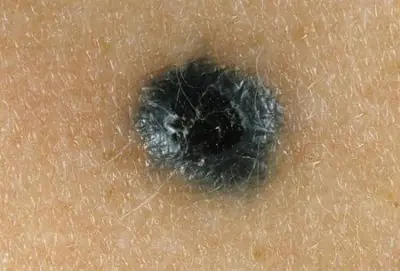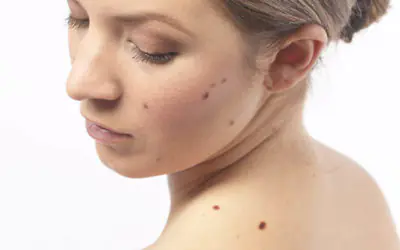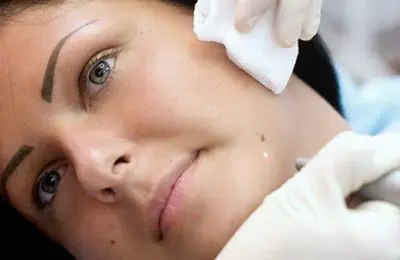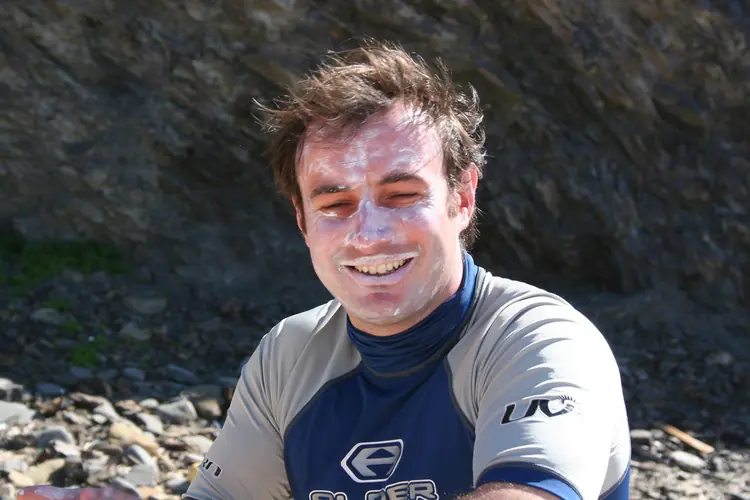Moles are rather mysterious formations of the human body. For many years, even the most famous doctors of their time could not explain what caused them. However, today you can easily get an answer to this question.
General characteristics of moles
Nevi that appear on the face create serious cosmetic problems. Many moles on the face can cause serious problems. They can be classified according to certain criteria. The main nevi include:
- Large pigmented spots. They are innate and their size increases with human growth. Most often these are gray or brown moles. After some time they may turn black. These spots are very dangerous, as there is a possibility that over time they will degenerate into a malignant tumor.

Blue moles. They got their name because of their color. They look like dense and smooth hemispheres appearing on the skin.- Convex moles. They form in the dermis. Such formations can be either flat or lumpy. In some cases, small hairs grow on them. The diameter of the nevus is less than one centimeter.
- Flat moles. More often than others they are found on the human face. They are formed in the uppermost layers of the skin. Such a nevus on the face does not change its shape and does not react in any way to sunlight. They very rarely develop into malignant tumors.
- Hemangiomas. Formed in the upper layers of the skin. Externally, they may differ from each other. Hemangiomas are red and hanging. There are also non-vascular hemangiomas, which look very similar to small warts. They do not bring discomfort or unpleasant sensations. At best, they disappear on their own after a few years. However, if they are damaged, they will be difficult to remove in the future.
Causes of moles
Many people are interested in why moles appear on the face. In order to find out why the number of moles on the face is growing, you need to familiarize yourself with the reasons. They may be different. These include:
- Ultra-violet rays. The face is exposed at any time of the year and is therefore exposed to ultraviolet radiation. Thanks to this, the human body begins to actively produce melanin, which is responsible for the appearance of nevi.

Heredity. In some cases, this problem can be transmitted from mother to fetus.- Accelerated growth of blood capillaries.
- Injuries.
- Exposure to x-rays or radiation.
- Viruses.
- Hormonal imbalance. Women are more likely than men to have this problem. Therefore, moles on the face of women appear much more often. They are formed due to frequent stress, abortion, pregnancy and menstrual cycles.
to contents ↑
How to avoid the appearance of nevi on the face?
There are a number of rules that will prevent the appearance of tumors:
- You need to spend less time in the sun. Sunbathing is recommended only in cases when solar activity subsides.
- While in the sun, the face and body should be protected with special sunscreens. Their defense level must be greater than 60.
- When walking during the day, you should take hats with you. At the same time, they should have large peaks and wide brims.
- You don't need to visit the solarium very often.
- It is recommended to monitor the hormonal levels of the body.
- You should visit a dermatologist several times a year to examine any moles that have appeared.
Health care
It is believed that moles on the face should be removed, as they negatively affect human health. However, not all have a negative impact. Therefore, there is no point in getting rid of a benign mole if it does not cause aesthetic discomfort.
There are a number of reasons when you should still pay attention to moles:

Their number has increased significantly.- They begin to grow very quickly. A large mole poses a danger to human health.
- Redness and bleeding appear.
- A burning sensation and unpleasant itching appears around them.
- Moles on the face begin to become inflamed, and the skin around them becomes swollen and red.
- The structure of the nevus began to change. It may become more lumpy and dense. Sometimes it becomes covered with cracks.
All these body signals should not be ignored. If at least one of the above signs appears, it is recommended to immediately contact a specialist.
Treatment of moles
Before treatment, examinations of the body are carried out. They will help identify possible contraindications for further procedures. A biopsy is required to make sure that there are no cancer cells under the mole. There are different treatment methods:
- Laser. Today it is the most popular procedure, since laser treatment practically does not cause any complications. The procedure is performed under local anesthesia and lasts only five minutes. Skin recovery may take several weeks.

Cryodestruction. In this case, moles are removed by burning them off using liquid nitrogen. The procedure is not so popular, since during its implementation healthy tissues are also damaged. The skin recovers within a month.- Electrocoagulation. Various DC or AC devices are used. Under the influence of electric current, the nevus is completely burned out. For the procedure, local anesthesia is administered. Complete skin restoration takes 10 days.
Surgery. After the advent of laser, surgical treatment is no longer very relevant. However, some salons use this technology, as it has its advantages:
- complete security;
- cheapness;
- a small number of contraindications;
- inability to re-proliferate cells.
Possible complications after removal of facial tumors
Even modern medicine and new technologies cannot guarantee that the removal of moles will not be accompanied by complications. They can be different:
- Infection and bleeding during surgical removal.
- The appearance of scars and cicatrices.
- In some cases, burns appear that will take a long time to care for.
- Damage to nearby healthy tissue.
The appearance of a large number of moles on the face can cause harm to health. Therefore, it is recommended to consult a doctor in a timely manner to solve this problem.
Moles (they are also called nevi or age spots) can appear on any part of the skin, Although most of them are on the faceprobably because it is this part of the body that is most often exposed to sunlight. So why do moles appear on the face and is it good if there are a lot of them?

Photo 1. A large number of moles on the face can be dangerous, as they are easily injured. Source: Flickr (Saman2p saman2p).
Moles: causes of appearance
The baby is born with clear skin without age spots - the first moles appear on it approximately after the first 6-12 months of life. During this period, the characteristic formations are small, there are few of them, so parents may not pay attention to them.
Nevi appear most clearly in adolescence, when, against the background of the active work of hormones, they become large, clearly colored and numerous. Also, due to changes in hormonal levels, formations occur in women - during puberty and the beginning of the first menstruation, during pregnancy, after abortion, against the background of regular exposure to stress and nervous tension.
It is impossible to say exactly why moles appear. Specialists The appearance of a large number of moles is associated with the active effect of ultraviolet rays on human skin. Moles-nevi are a cluster of cells saturated with the pigment melanin. Increased pigment production occurs precisely with active exposure to sunlight.
It is important! Moles appear on the face because it is this part of the body that is maximally exposed to the rays of the sun at any time of the year, so the cheeks and forehead may have the most age spots.
There is, however, something else explanation, not scientific, but popular: happy people have a lot of moles on their faces, who are destined by fate itself to be successful in all matters and endeavors. Even those who believe in such signs understand that in cases where there are especially many moles on the face, it is not only unsightly, but also dangerous.
What is the danger
In general, the danger of having nevi on the human body is that they can potentially be injured, which often results in degeneration of a benign tumor into a malignant tumor - melanoma.
This does not happen with 100% probability, since moles that do not bleed, do not change color or increase in size, and are not painful when touched are not dangerous to health.
Moles on the face can become not only a medical problem, but also a cosmetic one.. A large number of formations (if they protrude significantly above the skin) can limit some organ functions, for example, the movement of the eyelids or lips.
Since such nevi are constantly exposed to UV rays, they are highly likely to degenerate into melanoma, and frequent minor damage to moles can lead to the same result.
Wherein the more moles on the face and the closer they are located to each other, the less aesthetic the person’s appearance and the higher the risk of injury to formations.
It is important! Many moles on the face mean, at a minimum, the need to regularly visit a doctor who can promptly detect the beginning of the degeneration of formations into a malignant tumor.
Is it possible to remove nevi on the face?
The need to remove moles determined by specialist after examining the patient.
Most often it occurs in the following cases:
- If the mole began to change size, shape and color;
- If a glossy film, watery bubbles appear on the formation, or the pattern has changed its surface;
- if there are moles around there is a burning or itching sensation;
- If leather around the nevus annoyed;
- If visible blood stains and stains.
Since numerous moles on the face are quite a dangerous factor, they are often subject to injury, there is always a risk of nevus degeneration into malignant formations, they should be removed if possible. eliminate in a timely manner.
It is important! If a person has many moles on his face and wants to get rid of them, he should remember that interventions on such an exposed part of the body are carried out only in the cold season, when solar activity is minimal. The exception is cases when nevi are already malignant. They are removed immediately after detection.
How moles are removed from the face
Treatment for numerous pigmented growths on the forehead and cheeks begins with clarifying and eliminating what is causing moles to appear on the face. If a hormonal imbalance is detected the patient is prescribed corrective drugs. If the cause of numerous rashes of nevi on the face is ultraviolet rays, the patient is advised to change their usual lifestyle, avoid prolonged exposure to the sun with the obligatory use of sunscreen.
After eliminating the main cause, the actual mole removal is prescribed. There are several methods that allow you to achieve excellent results in getting rid of unwanted growths on the skin:
- surgical excision – removal using a surgical scalpel of formations that have begun to degenerate into a malignant tumor, especially large and deeply rooted moles;
- cryodestruction – exposure to the formation of liquid nitrogen, a procedure during which the cells freeze, dry out and die, is quite effective, but requires repeated repetition;
- electrocoagulation – manipulation with high-frequency current, due to which the mole is burned out, an effect that leaves behind scars, therefore used mainly for small nevi;
- radiosurgery – cauterization of the mole with a special radiocoagulator device, which simultaneously removes the affected tissue, stops bleeding, and heals the resulting wound, as a result of which no traces remain on the operated area;
- laser removal – destruction of the formation by laser action, extremely effective, practically painless, leaving behind a minimum of scars, and also avoiding complications and relapses of the procedure.
Therapeutic measures after removal of moles on the face should consist of taking care that the operated skin not exposed to sunlight, and in the first days you should avoid even water procedures.
5-6 days after the intervention, the wounds can be carefully rinse with an antiseptic, lubricate with Vaseline and cover with a sterile bandage.
When the scab that has formed disappears, we can consider that the removal procedure was successful.

Photo 2. Immediately after removing moles, it is better not to expose yourself to the sun; subsequently, use a protective cream. Source: Flickr (Amy Glaze)
Moles on the face and body are no different from each other. Both of them manifest themselves under the influence of a hormonal surge and increased solar activity. Both of them can eventually degenerate into malignant formations, so they often have to be removed.
Moles are considered benign. They are formed due to the accumulation of melanin in skin cells. The number of birthmarks increases with age. A newborn baby does not have nevi on the body. Starting from the second year of life, spots appear on the body. The formations vary in color, shape and size. It is often found that the nevus is covered with hair. This phenomenon suggests that education is not dangerous for humans.
The main reasons for the appearance
A person wonders why moles appear on the face. Their location can be on the eye, on the oral mucosa or on the head. A mole most often occurs in women. This is due to periods when hormones surge. If the growth is convex or hanging, and has a black color, the woman prefers to disguise it with the help of cosmetics. If cosmetic products do not bring results, go to the hospital for removal.
Moles on the face grow for the following reasons:
- Long and frequent exposure to sunlight during the summer season. Ultraviolet radiation is the main cause of melanin production and the appearance of new formations on the face. When sunbathing, you must use protective creams and wear a hat.
- Effect of X-rays.
- Infectious diseases in the body that are in the acute stage.
- Radiation exposure.
- Hereditary factor. While in the womb, birthmarks can be passed on to the baby. They grow up at an older age. For example, if a woman or man has many moles on their face, then their child will have an approximate number during adolescence.
- Hormonal disorders. They occur when carrying a child, during puberty in adolescents, and during long-term use of hormonal drugs. This includes the age factor when menopause occurs. Hormonal imbalance occurs during abortion, menstruation, and stressful situations.
Types of moles on the face
A birthmark on the face causes aesthetic discomfort to a person. Especially if the nevus is large or hanging.
Formations are of the following types:
- Angioma. It has a bright red color. It is colored due to the large number of blood vessels that are located in the upper layer of the dermis. Angioma occurs due to impaired functioning of the pancreas.
- Flat education. They can be small and large. Appear due to the accumulation of melanin. They have weak reactions to exposure to ultraviolet radiation. In rare cases, the process of proliferation may begin.
- Blue moles. They appear in both small and large sizes. The color ranges from light blue to dark blue. The structure of the blue nevus is dense and the surface is smooth. They protrude above the surface of the skin by 2–3 mm.
- Hemangioma. The red color of the mole is due to a large accumulation of blood vessels. Located on the surface of the epidermis. They have the shape of a nodule or hanging growth. The cause of the occurrence is pathological processes in the blood vessels.
- Convex. It occurs on the face more often than others. A symmetrical formation that is not dark brown in color. The coloring is similar to skin color. A sign of a safe nevus is a hair growing from it.
What is the danger
Moles located on the face are not dangerous to humans. Except in cases where the stain is not subjected to regular mechanical stress. As a result of injury, changes occur that indicate the degeneration of the nevus into a malignant tumor. Symptoms of conversion:
- The mole began to bleed. The causes are mechanical damage or random bleeding. In the latter case, you should seek help from a doctor, as this is a sign of the development of cancer cells.
- Cracks appeared on the surface of the build-up.
- Enlargement of a mole.
- It started to swell.
- Pain is felt when pressing.
- The process of inflammation has begun.
- The surface and the area around it peel off.
- Blurring clearly defined boundaries.
- Color change. The nevus turns red or black.
- Loss of hairs growing from the birthmark.
If one of the alarming symptoms is present, the nevus becomes dangerous to humans. Signs of degeneration require an immediate visit to an oncologist or dermatologist.
Recommendations for removing moles on the face
It is recommended to remove moles that spoil a person’s appearance. Doctors also prescribe getting rid of those formations that are subject to systematic injury. Nevus on the neck can be damaged by jewelry. A man, while shaving, can cut off a nevus on his cheek. If the formation is located on the head, it can be injured when combing the hair. Spots that are located in the abdomen or feet are torn by tight belts and shoes. The main indication for removing a birthmark is the risk of transformation into a malignant tumor.
Separately, it is worth considering the case when there are many nevi on the face. This situation requires a thorough examination, during which the cause of the appearance is determined. Multiple stains not only spoil the appearance, but will also become dangerous if exposed to external or internal factors. Before undergoing surgery, it is recommended to consult a doctor. He will determine which removal method is right for the patient and when it should be done.
It is worth remembering that nevus must be removed in the cold season. During this period there is less ultraviolet rays. If removal was required in the summer, the doctor will prescribe a wound care regimen. It is based on the use of sunscreen, hats, and glasses. The operation is prohibited during pregnancy and in case of infectious and viral diseases. It is important to take into account the age factor. For young children, moles need to be removed only if they have become malignant. An adult can get rid of formations that cause aesthetic discomfort.
Removal methods
Whether it is possible to remove moles on the face and which method is best to choose can be determined by a qualified doctor. The choice is based on the results of the examination, which consists of dermatoscopy, histology, and biopsy. The doctor takes into account the structure and size of the mole, its nature, as well as its location, and then selects the appropriate method that will eliminate the consequences.
If you have a question about how to get rid of moles on the face, it is recommended to contact clinics that offer several ways to get rid of moles:
- Surgical. Removal is done with a scalpel. The site is injected with an anesthetic drug, then the nevus is cut out. The stitches are removed after two to three days. The removed lesion is examined in the laboratory for the presence of cancer cells. The procedure has a low price. The downside is the scar after the operation. Used for large nevus size.
- Radio wave. Surgitron is used for removal. Patient reviews say that the process takes five minutes, during which there is no pain. No anesthesia is required. There is no scar left. After removal, the mole will not grow back, so the method has positive reviews.
- Laser removal. The burning procedure takes 10 minutes. There is no bleeding during the operation. There will be no scar left. There is no possibility to send a remote lesion for histological examination.
- Electrocoagulation. High frequency current is applied. After surgery, the mole may appear again. There is also no way to extract the roots of the nevus.
- Cryodestruction. Using liquid nitrogen, the nevus is frozen and its tissues die. Moles on the face are not removed in this way, as the wound heals in 4–5 weeks.
You can get rid of moles using folk remedies. The condition is the doctor's permission to carry out treatment at home. Traditional methods:
- Lubricate the nevus with a cotton pad soaked in an infusion of celandine and alcohol. Pour two tablespoons of chopped herbs into a glass of ethyl alcohol. Leave for three days. Duration 5–7 days. Treat twice a day.
- Spread the formation with acetic acid or iodine. Carry out with caution, as the skin on the face is sensitive and may cause burns. The duration of the procedure should not exceed three days.
- Mix two tablespoons of flaxseed oil (buy at a pharmacy or prepare it yourself) with a tablespoon of liquid honey. Moisten a cotton pad, apply it to the nevus, and cover with a band-aid. Remove after five minutes. Carry out the procedure in the morning and evening.
- Potassium permanganate solution. Pour three to four granules of potassium permanganate into a glass of boiled water. Soak a piece of sterile bandage folded in four in the solution. Apply to the growth. Remove after 10 minutes.
- Lubricate the nevus with zinc or salicylic ointment. It is allowed to use an ointment that contains an antibiotic.
Complications
Despite the many advantages of modern removal methods, complications may arise:
- The electrocoagulation method and the use of a scalpel leave deep scars on the face.
- When using liquid nitrogen, the roots of the nevus are not removed, which threatens the reappearance of the formation on the face.
- The presence of burns after the cryodestruction method, which disappear over a long period of time.
- When using a scalpel, bleeding from the wound opens, which increases the risk of infection.
- Liquid nitrogen freezes the tissues located next to the formation.
- When removing a growth at home, there is a high risk of melanoma. The disease can be fatal.
If you use the removal of moles on the face: reviews, the consequences depend on the structure and size of the nevus, location and individual characteristics of the body.
Features of care after surgery
How to care for the wound after surgery depends on which method of removal was used. Recommendations are given by the doctor who performed the operation. General rules: do not wet the wound, do not use cosmetics, do not peel off the crust that has formed. Avoid being in direct sunlight for 7-10 days. Do not visit the solarium. Do not remove hair from the area of skin where surgery was performed. Refrain from getting tattoos. The remaining measures will be indicated by the doctor.



